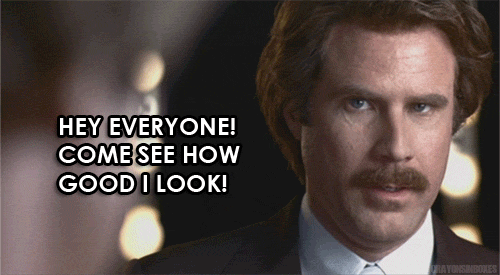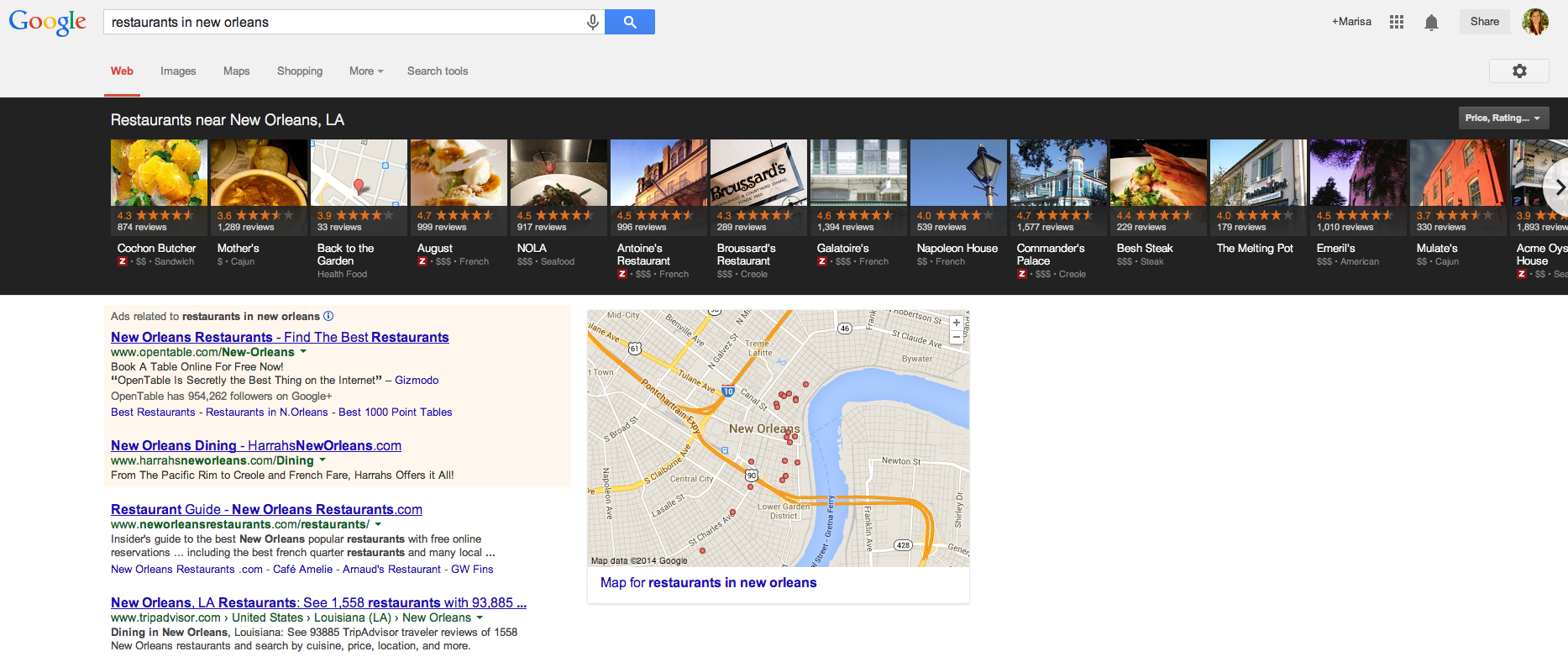Everything You Need to Know About Google Carousel
January 20th, 2014 by
Whether you’re looking to improve your position or simply figure out what the heck this carousel is doing in your Google search results, this blog post is for you. Let’s start out with a little background information.
What is the Google Carousel?
As you have probably noticed by now, Google has incorporated a new carousel into several of its search results. If you haven’t seen it yet, the carousel is a row of about 20 listings displayed in a long black box at the top of search results. The image below shows an example of the carousel pulled for the search query “restaurants in new orleans.”
Click the image below to enlarge
How Does it Work?
Google pulls the information for each carousel listing from the Google+ pages of relevant businesses. Upon clicking a result in the carousel, another search will be performed for that brand. There are pros and cons to having these carousel results display in searches related to your business. Here are just a few:
Pros of the Google Carousel
-
Your website could potentially be displayed in 2 locations on Google search results: the carousel and regular Google organic results below the carousel. Psst – if you’re looking for some help with those organic rankings I know a guy…
-
If you have great reviews and ratings on your Google+ page, your average star rating will appear as a fantastic means of comparison to your competitors (who may not have the same stellar rating as you)
-
Results are displayed ABOVE paid search results, putting you ahead of competitors who are paying to hold that prime real estate above the fold
-
If done carefully, some service area businesses can rank for local searches in the carousel where they may not have appeared in map pack results before the carousel
Cons of the Google Carousel
-
When clicking a carousel result, another search is done for your brand rather than being taken to your website or Google+ page, which means more clicks are needed to get to your website and may result in a drop off of potential visitors
-
The carousel occupies a lot of space “above the fold” in search results, pushing down those precious organic results you worked so hard to obtain
-
Google chooses the image that is displayed in each carousel result from the images that are uploaded on your Google+ page
There are a number of keywords and phrases that trigger the carousel. Mike Blumenthal has compiled a list of 300+ keywords and phrases that trigger these results. From a business standpoint, there are several reasons why you want to review these search terms and determine if search queries related to your industry are pulling this carousel, and whether or not your company shows up in the results.
The Optimal Carousel Location
A study of user engagement performed by Mike Ramsey suggests that the optimal locations in the carousel are positions 3 and 8, while Ethical SEO did a similar study and found that the 1st and 5th positions in the carousel were most popular. Although the exact prime locations differed, the main takeaways from these studies tell us the following:
-
Searchers are clicking in the carousel
-
30% of people in Ethical SEO’s study
-
48% of people in Mike Ramsey’s study
-
-
Reviews and ratings are important
-
Searchers cited Zagat scores and amount of reviews on a particular result as determining factors for clicking
-
-
Images should be eye catching
-
In Mike Ramsey’s study, the carousel listing with the highest Zagat rating and number of reviews that contained a boring gray exterior photo of the restaurant was not clicked nearly as much as the result next to it that featured a beautifully plated entree
-
Lookin’ Good in the Carousel
 If you have little or no reviews on your Google+ page, what are you waiting for? You’ve worked hard to establish your business and provide positive customer experiences. Build up your following on Google+ and don’t be afraid to remind customers of your brand. Encourage potential and current customers to read your reviews. Highlight previous testimonials or reviews in Google+ status updates. Post pictures of your product, staff, events – anything to send your audience down memory lane and potentially inspire them to recount their experience in the form of a review.
If you have little or no reviews on your Google+ page, what are you waiting for? You’ve worked hard to establish your business and provide positive customer experiences. Build up your following on Google+ and don’t be afraid to remind customers of your brand. Encourage potential and current customers to read your reviews. Highlight previous testimonials or reviews in Google+ status updates. Post pictures of your product, staff, events – anything to send your audience down memory lane and potentially inspire them to recount their experience in the form of a review.
As mentioned previously, Google will select the image that appears in carousel results, so be mindful of the images you upload to your Google+ page. If you are a restaurant, upload images of plated dishes. If you are a jewelry store, upload images of your most popular designs. A good image will differ from industry to industry, however, across the board a good image will be:
-
Attractive
-
Eye catching
-
Clear (don’t upload stretched out or blurry images!)
-
And depict what you do
Top Ranking Factors
If you’ve been diligently working to improve your rankings for the map pack in blended results, many of those efforts also contribute to carousel ranking factors. Search Engine Journal’s recent study cites three top factors for ranking in the carousel: social signals, external factors, and content structure. The strongest of these appeared to be social signals, which include:
-
 Amount of +1s on your Google+ page
Amount of +1s on your Google+ page -
Amount of +1s on a website’s URL that is attached to your Google+ page
-
Amount of reviews on your Google+ page
-
Rating of your Google+ page
Next, external factors proved very important. In particular, the number of citations across the internet was cited as the most important external factor. An additional point to that is these citations should be clean and correct across the board. You may have several location citations, but it will only serve to confuse Google if the information is not consistent from one citation to the next. All this should sound familiar, as citations are nothing new to local search ranking factors and something Search Influence has preached for years.
The last of these top ranking factors is content structure. Placing the keyword in the title, the location in the title, the keyword in the URL, and the location in the URL were all found to have a correlation to rankings. Although these factors are important, you don’t want to come off as sounding unnatural or spammy. Do exercise caution with these aspects of content structure, as you want this content to be natural.
With any new update or change Google makes, there is always more to be found and mentioned. What are some things you’ve noticed about the Google carousel? What factors have you seen improve carousel rankings? What trends and/or benefits have you noticed since Google rolled out the carousel? Sound off in the comments!

 Amount of +1s on your Google+ page
Amount of +1s on your Google+ page
SO happy to see a blog post about this!!! The Carousel was mentioned on a lot of blogs and webinars as something to pay attention to in 2014. Consumers are so very driven by visuals these days, so having a good photo in the carousel is DEFINITELY going to a crucial click factor. It’s also cool that you don’t necessarily have to rank first in the Carousel as long as you have a captivating/ relevant image.
It looks like a lot of the Carousel photos are whatever the first photo that was uploaded to the account was(even if it wasn’t uploaded by you). Google’s current solution to changing your Carousel photo is to delete all account photos then re-upload them making sure that the first photo you upload is the one you want in Carousel. Not a very practical solution and might not work if someone besides you uploaded the first photo, but at least it’s something.
See this blog to learn more about how the photo is determined:
http://www.rankhammer.com/blog/1202/local-carousel-photos-might-screwed